Why is keyword research important?
If no one searches for a published page’s topic, it won’t get any organic search traffic from search engines.
Keyword research is critical to ensure that there is search demand for your content.
If your page ranks well in Google for its target keyword, you’ll get lots of targeted visitors.
How to find keywords for your SEO Strategy
To do keyword research, consider how your customers search for solutions and use Semrush’s Keyword Magic Tool, Ahrefs Keyword Explorer, or Google Search Console to find more relevant keywords.
To do it well, you need to be prepared with a few things, and the process is simple to find keyword opportunities:
- Be well-versed in your industry or niche; people want to read from people who know their stuff.
- Knowing how keyword research tools work, I have played around with SEO tools for years. Experience makes you more efficient.
- Be in a creative mindset. While the data can be precise, be ready to think outside the box.
- Think about the long term, and what are you trying to achieve in SEO?
Afterward, it is necessary to determine the most suitable keywords for your website.
There are two types of keywords: short-tail and long-tail.
Short-tail keywords are a type of keyword that is composed of fewer words.
Long-tail keywords are a type of keyword composed of lots of words.
OK, now that we’re ready, here are the basics of keyword research.
Start with ‘head term’, ‘fat head’, or ‘seed’ keywords
Think of primary keywords as the starting point of your SEO journey.
They are broad, general terms that describe your product, service, or content. These keywords help to identify your niche and guide your more detailed keyword research.
You can also call them ‘fat head’ keywords.
Business owners need to know how their unique selling point connects with these organic keywords; it’s a valuable insight.
For example, if you’re in the business of selling gardening tools, your seed keywords might include:
- “Gardening tools”
- “Plant care”
- “Garden equipment”
- “Horticulture supplies”
Remember, seed keywords are just the beginning. They’re not typically targeted directly for SEO efforts. Instead, they’re used to generate a broader range of specific keywords and phrases that potential customers might use to find products like yours. So, don’t spend too much time on them – a few broad ideas are enough to start.
Keyword research through competitor analysis
Let’s talk about how to uncover the keywords that work well for your competitors, which is an intelligent move in SEO.
First, you’ll need to identify your competitors. Your list of seed keywords can be a great starting point. Search for one of these keywords on Google and see which websites appear on the first page. These are your potential competitors.
However, not all are directly comparable to your website. For instance, if you’re selling fitness equipment, you might find more relevant competitors under specific searches like “home gym equipment” rather than broader terms like “fitness.”
Once you’ve identified a few competitors, you can use tools like Semrush Keyword Overview.
Enter your competitor’s website into the tool to see their top traffic-driving pages and the keywords they target. This can give you insights into which keywords are valuable in your niche.
By repeating this process with several competitors, you’ll end up with a substantial list of relevant keywords. This method accelerates your keyword research and provides a clear view of what’s working in your market.
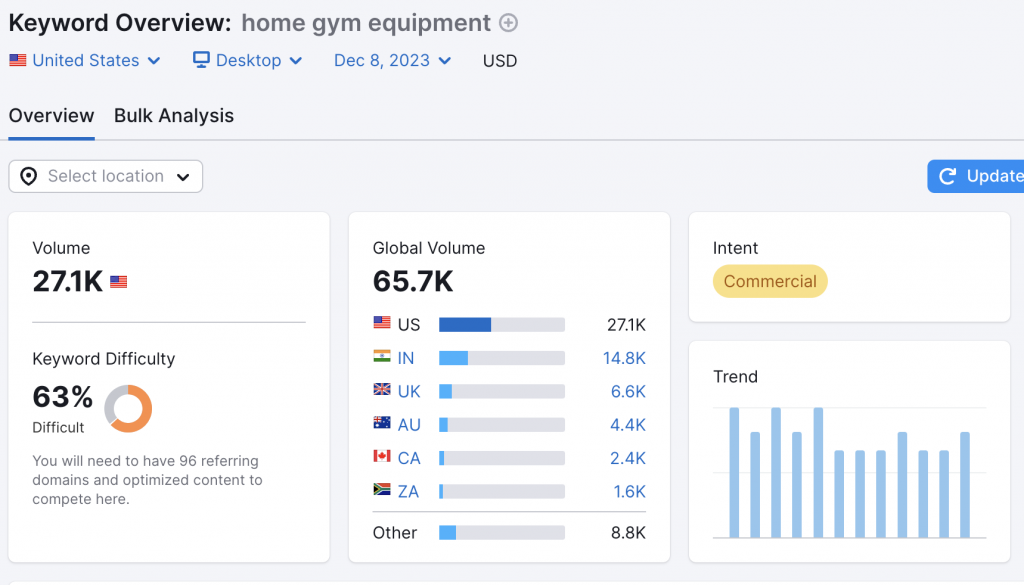
Keyword Gap Analysis in Semrush:
The tool highlights keywords your competitors rank for, but your site needs to. This can help you identify unique keywords and discover gaps in your competitors’ strategies. It’s also useful for PPC research by identifying keywords with high competitor rankings but low advertising competition.
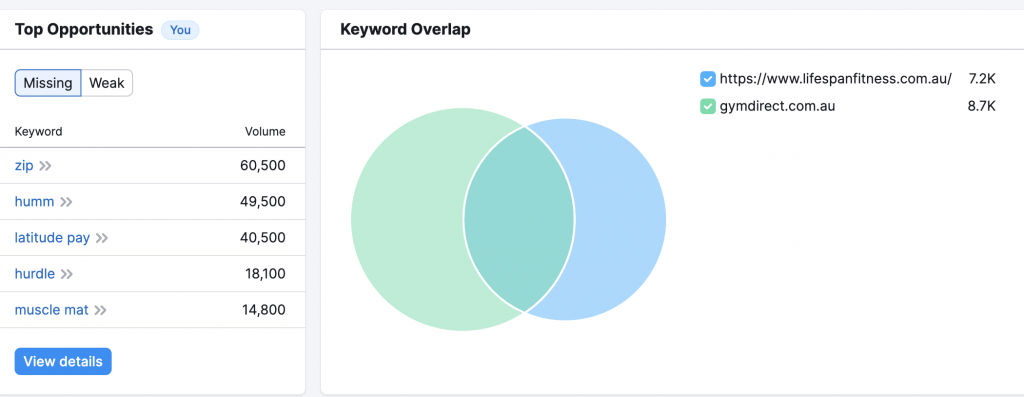
Use free keyword research tools
Keyword research tools are essential for uncovering potential keywords your competitors might need to target.
These tools operate on a simple principle: you input a seed keyword, and they generate a list of related keyword ideas from their databases.
Google Keyword Planner is a prime example of such a tool.
It’s free, and while primarily designed for Google Ads campaigns, it’s equally valuable for SEO keyword research. By entering a seed keyword like “coffee,” this tool can provide a variety of related keyword ideas, expanding your potential SEO targets.
The beauty of using tools like Google Keyword Planner is that they can reveal less apparent keywords that are still highly relevant to your audience.
These tools offer a broad view of potential search queries, helping you identify opportunities you might not have considered otherwise.
It is important to note that Google Keyword Planner can generate keyword ideas that don’t necessarily contain your seed keyword.
Take the keyword “percolator,” for example. Unless you’re a hardcore coffee connoisseur, this may not relate to coffee, making Google Keyword Planner a helpful tool for discovering non-obvious keyword ideas.
When you find an exciting keyword, use it as your new seed keyword to get new keyword ideas.
You can also use Google Keyword Planner with competitor websites instead of purely using broad-match keywords.
- Select a Competitor: Choose a successful competitor’s website in your niche.
- Analyze Their Website: Examine their content and keywords to understand their SEO strategy.
- Use Google Ads Keyword Planner: Input the competitor’s website to discover the keywords they rank for.
- Gain Insights: Learn what keywords and content work well in your niche.
This method is more targeted than broad keyword searches, saving time and increasing efficiency.
Beyond Keyword Planner, there are several other free keyword research tools. These are great if you’re starting, but you’ll soon realize they’re pretty limited in data and functionality.
While free keyword research tools are a good starting point, they often need to be improved in data and functionality.
Professional tools like Ahrefs’ Keywords Explorer are worth considering for a more comprehensive approach.
These tools provide deeper insights and a more extensive variety of keyword suggestions, which can be invaluable for growing your website’s search traffic. Inputting seed keywords into these advanced tools can yield many keyword ideas, significantly enhancing your SEO strategy.
People Also Asked Feature:
The “People Also Asked” feature in the context of keyword research is a great tool:
Matching Terms:
This aspect focuses on keywords containing your seed keyword. There are two modes:
- Terms Match – If your seed keyword is “solar panel,” you might see terms like “solar panel installation” or unrelated ones like “panel discussion on solar energy.”
- Phrase Match – With “mountain bike” as the seed keyword, this mode might return phrases like “best mountain bike trails” or “mountain bike accessories sale.”
Related Terms
This report shows keywords that don’t necessarily include your seed keywords. It features two modes as well:
- Also, Rank For: Reveals queries for which top-ranking pages for your seed keyword also rank. This helps you understand the broader topics or questions your audience might be interested in.
- Also, Talk About: Highlights words and phrases frequently mentioned on top-ranking pages for your seed keywords. This can uncover related topics or concepts that are relevant to your audience but may need to be more direct keyword matches.
- Semantically related keywords: When talking about “smartphone technology,” it’s important to know that there are related keywords like “mobile device advancements,” “wireless connectivity,” and “app development.” These terms are all connected to smartphone technology.
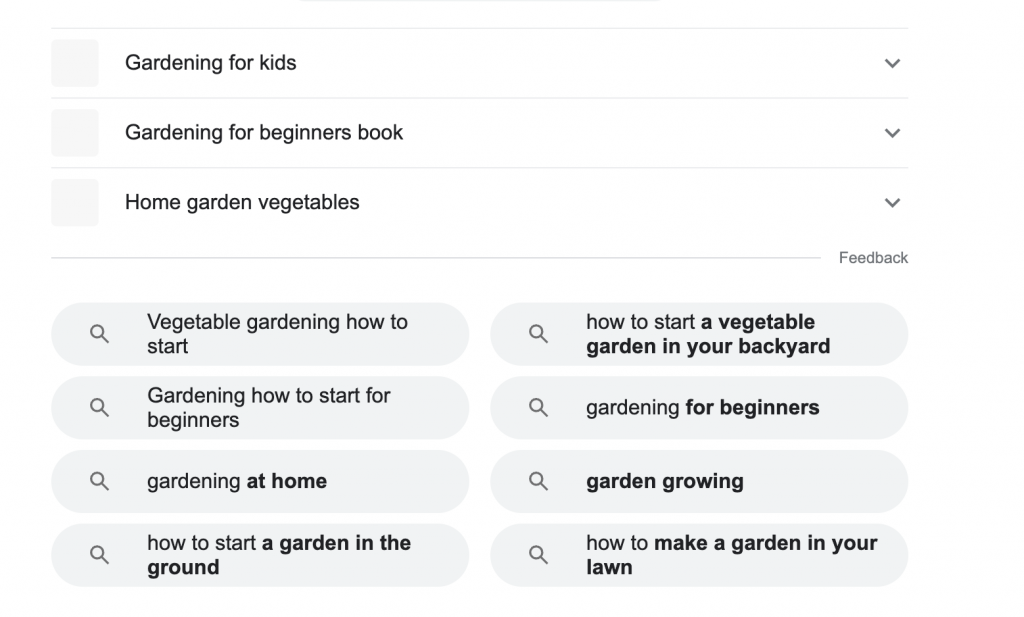
The “People Also Asked” feature thus offers a comprehensive way to explore direct and related keyword ideas, broadening your SEO strategy to cover a broader range of potential search queries.
Generate keyword ideas for your niche.
While traditional methods give numerous keyword ideas, they can be limiting:
Using Tools to Analyze Trends for Keyword Ideas
Google Trends is a valuable tool for understanding the trending nature of searches. It can give insights into whether a keyword’s popularity is increasing, stable, or declining.
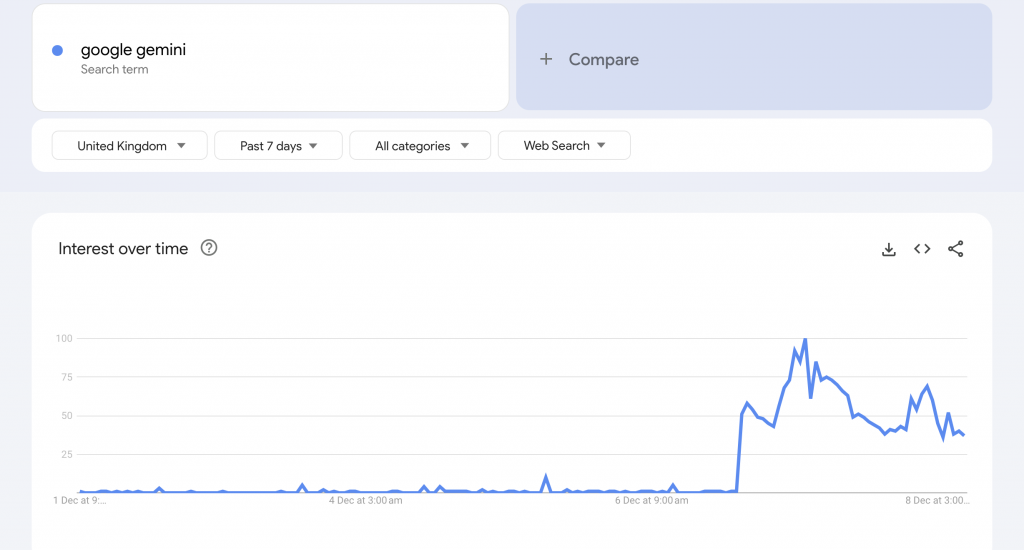
Think outside the box!
A great strategy is to explore where your target audience spends time, like forums, online groups, or Q&A sites.
Observing their discussions can reveal what interests them.
Example:
On a subreddit like /r/gardening, you find a post about the “best soil mix for indoor succulents.” This topic might not be a high-volume search term, but the enthusiastic participation in the forum indicates a strong interest. Though they might not top search charts, topics like this can deeply connect with and provide value to your audience.
Learn from your customers
Conversations with customers are goldmines for keywords.
Their language and frequent questions can inspire unique and relevant keyword ideas for your website.
AI Tools like ChatGPT
ChatGPT is an intelligent AI because it’s been trained with a ton of information. It’s super quick at answering questions and can think a bit like a human, thanks to a method called Reinforcement Learning from Human Feedback (RLHF). This makes it a valuable tool for SEO.
You can use specific prompts to turn ChatGPT into a keyword research tool. For example, ask it to generate long-tail keywords for a particular topic, suggest LSI keywords related to your main keyword, help organize your keywords into groups, or analyze the search intent of a keyword list.
Here’s an example prompt to use for finding niche keywords:
“Prompt:
Imagine you’re a market research expert with a firm grasp on keyword analysis and adept at forming SEO content strategies.
Please create a table for an SEO content plan centered on
- Keyword Cluster: Identify the main category of the keywords.
- Long-Tail Keyword: Provide a specific long-tail keyword for each category.
- Search Intent: Define the human search intent behind each keyword (commercial, transactional, or informational).
The response should be in a table format, focusing exclusively on these three columns: Keyword Cluster, Long-Tail Keyword, and Search Intent. The table should offer clear, SEO-optimized insights without additional information beyond these specified categories.”
Here’s the output:
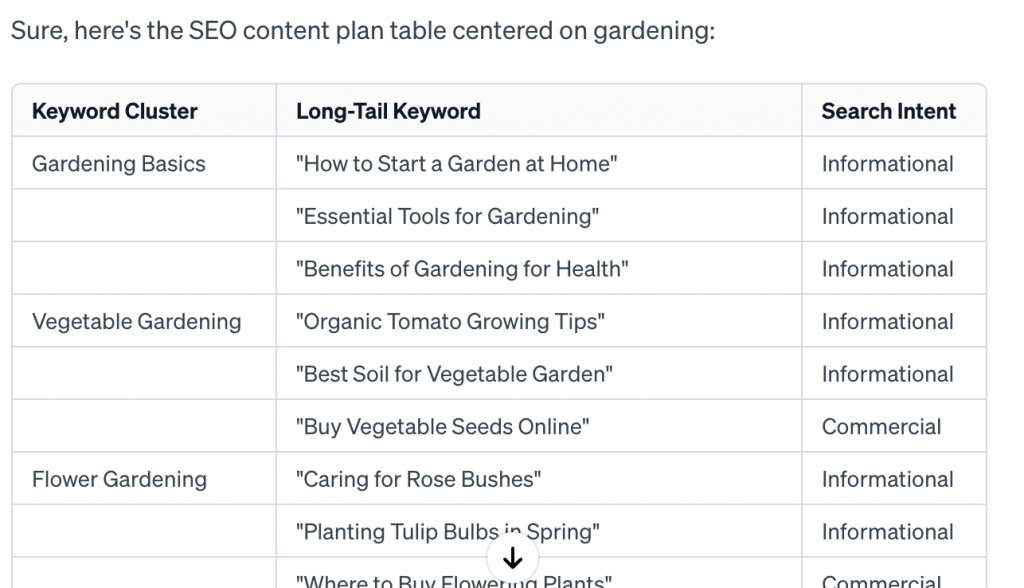
How to analyze your keywords
Analyzing your keywords is a crucial step in SEO to ensure you’re targeting the correct terms to drive relevant traffic to your site. Here’s a simple guide on how to do it:
- Relevance: It’s essential to consider how relevant a keyword is to your content and audience. A highly relevant keyword aligns well with your audience’s interests and the subjects you cover.
- Search Volume: This measures how often a keyword is searched for. It gives an idea of the keyword’s popularity. However, remember, high search volume only sometimes means high relevance to your audience and monthly search volumes.
- Keyword Difficulty: This metric indicates how challenging it will be to rank for a particular keyword. Lower difficulty scores are often more approachable for newer or less authoritative sites.
- Click-Through Rate (CTR) Potential: This predicts the likelihood of someone clicking on your site after searching the keyword. Keywords with higher CTR potential are generally more attractive because they suggest a higher level of searcher intent.
- Traffic Potential: Based on the blend of volume and click-through potential, it’s the forecast of traffic based on those data points for organic traffic.
- CPC: If a keyword has a high CPC, it often means it’s a popular keyword that many businesses are willing to pay more for. This can signal that the keyword is valuable and might bring quality traffic to your website.
Using these metrics, you can filter through countless keyword ideas and identify those most beneficial for your SEO strategy.
It’s about balancing popularity, competition, searcher intent, and relevance to your content. This way, you can focus on keywords that have the potential to drive targeted traffic and engagement to your site.
Keyword Relevance
Keyword relevance is how closely your chosen keywords match the theme or subject of your website, product, or service.
For your website to show up high in search engine results (like on Google), the keywords you use need to be closely related to what’s on your site. Your website might show up little in search results if they’re relevant.
Regarding SEO, the main goal isn’t just to drive any traffic to your website but to attract the right traffic. For instance, if your product isn’t related to “soap,” optimizing for this keyword won’t help.
Even if you rank number one for “soap,” the visitors you attract won’t find what they’re looking for on your site. This mismatch can lead to two main issues:
- Poor Conversion Rates: Visitors who land on your page looking for dish soap won’t be interested in your product or service, leading to low conversion rates.
- Negative Impact on Rankings: Google and other search engines aim to provide the most relevant results. If your page ranks high for an irrelevant keyword, it might initially attract traffic, but Google will eventually realize the content doesn’t match the search query and will lower your ranking.
Choosing Between Relevant Keywords
When you’re unsure which keyword variation to choose, always choose one that’s more relevant to your content. This approach helps in several ways:
- Better Conversion Rates: More relevant keywords mean visitors who are interested in what you offer, leading to higher chances of them taking action on your site.
- Improved User Experience: Visitors get what they expect when they click on your site, which can lead to longer visit durations and better engagement.
- Higher Search Engine Trust: By providing relevant and valuable content for specific keywords, you build trust with search engines, which can improve your overall SEO performance.
Traffic vs. Conversion
It’s a common misconception that more traffic always equals better results. However, in SEO, quality often trumps quantity. It’s more effective to have a higher conversion rate on a smaller amount of highly targeted traffic than a minuscule conversion rate on a large volume of irrelevant traffic.
Search volume
Let’s break down the key aspects of the search volume metric in SEO, making it easier to understand its significance and application.
Understanding Search Volume in SEO
Counts Searches, Not Searchers:
Search volume represents the total number of searches per month for a keyword, not the number of unique individuals searching.
A single person might search for “restaurants in Paris” multiple times, contributing to the overall search volume for that term.
Doesn’t Guarantee Traffic:
Ranking high for a keyword doesn’t mean you’ll receive traffic proportional to its search volume. At best, you might get around 30% of the search volume in traffic if you rank at the top.
Based on Annual Averages:
Search volume is calculated as an annual average. So, a keyword with a high search volume in a specific month but low for the rest of the year will still show a consistent monthly average.
A keyword with 300,000 searches in July but none in other months would offer a monthly average of 25,000 searches.
Varies by Country.
Search volume is often specific to a country, but some tools also provide global search volume, aggregating data across all countries.
Considerations for Search Volume
Remember, search volume might differ slightly between various SEO tools due to differences in their calculation and update methods.
Keep an eye on trends, as the annual average might not reflect current search patterns. For instance, a keyword might show a high yearly search volume but could be declining in popularity.
Keyword Difficulty
Keyword Difficulty is a measure SEO experts use to determine how hard it is to rank for a particular keyword. To do this, they look at various factors by analyzing the search results for each keyword. These factors include:
- Search Intent: Understanding why people are searching for a particular term.
- Content Quality: Looking at the depth, relevance, freshness, and authority of the content currently ranking.
- Backlinks: Evaluating the number and quality of backlinks pointing to a page.
- Domain Rating: Assessing the overall strength and reputation of a website.
- SERP Features: Checking for special search result features like featured snippets.
- Other Factors: Considering various other elements that might influence rankings.
Different SEO professionals may prioritize these factors differently. For example, one might focus more on Domain Rating, while another might think content relevance is more critical. The type of search query can also influence this variation in opinion.
For SEO tool creators, simplifying this complex analysis into a single metric, like a Keyword Difficulty score, is challenging. Despite differing opinions, most professionals agree on the importance of backlinks for ranking.
Therefore, many SEO tools base their Keyword Difficulty score on the number of unique websites linking to the top 10 ranking pages for a keyword.
However, it’s essential to understand that this score indicates the estimated number of linking websites needed to rank in the top 10, not necessarily at #1.
Limitations of Keyword Difficulty Metric
While keyword difficulty is a helpful indicator, it doesn’t cover everything that affects how well a keyword might rank in the keyword research process. It focuses a lot on backlinks but often misses other crucial factors like the quality of the content, what the user is actually looking for (user intent), the context of the search, and any recent updates to search engine algorithms.
For instance, a keyword phrase with low difficulty isn’t always an easy win, especially if the top content is really high quality or spot-on for what users are searching for.
On the flip side, a keyword with high difficulty isn’t necessarily out of reach, especially if the current top content is outdated or not great.
Cost Per Click (CPC)
CPC is a term often used in online advertising. It tells us how much advertisers pay each time someone clicks on their ad.
For example, if the CPC for the keyword “luxury car rentals” is $50, advertisers will pay $50 every time someone clicks on their ad for this keyword.
Why is it high?
People searching for this are likely looking to buy something, making them valuable potential target customers.
On the other hand, a keyword like “history of the internet” has a lower CPC, say $3. This is because it’s primarily about seeking educational information rather than purchasing a product or service, making it less valuable for advertisers.
It’s important to know that CPC can change a lot and quickly. Unlike search volume (how often a keyword is searched), which usually stays the same, CPC can fluctuate as more ads compete for the exact keywords.
The CPC you see in SEO tools is just a snapshot at a particular time and might need to be more accurate. It’s best to use tools like AdWords to get real-time CPC data.
Now, about targeting keywords:
When you’re looking into keywords, it’s crucial to figure out what kind of webpage you need to create to rank well in search results.
Think about whether you can target several related keywords with one page or if you need separate pages for different keywords.
Understanding Traffic Potential
Imagine you’re targeting the keyword “organic coffee beans.” Instead of just looking at the traffic for this specific keyword, check out the total organic traffic for the top-ranking pages for this term.
For instance, the top-ranking page for “organic coffee beans” in the UK might attract 15,000 unique visitors a month and also ranks for over 300 other related keywords.
By focusing on the overall traffic these top pages are drawing, rather than just the individual stats for “organic coffee beans,” you get a more accurate picture of the potential traffic your page could capture. It’s like understanding the popularity of a coffee shop not just by its signature drink but by its entire menu and customer base.
This broader view helps in forming a more robust and realistic expectation of the organic traffic that your key pages could generate. It’s about looking at the whole forest, not just a single tree.
Gauging the traffic potential by considering the total organic traffic of top-ranking pages, instead of just individual keyword stats, can lead to a more effective and comprehensive SEO strategy.
Content Strategy Over Just Keyword Research
Real success in SEO comes from understanding and creating content that’s even better than what currently tops the search results. This means focusing not just on keywords, but on a well-thought-out content marketing strategy.
Instead of relying only on keyword tools, it’s crucial to actually read and understand the articles that rank highly for your keywords.
Why are they successful? What makes them stand out?
Look at how they present information, the clarity of their content, the use of multimedia, and overall user experience. Most importantly, see how well they meet the reader’s needs.
Once you understand what the top articles are doing right, aim to create content that’s even better. This doesn’t just mean adding more information. It’s about making your content more valuable and relevant to your audience.
This could involve clearer explanations, updated info, better visuals, more thorough coverage, answering additional questions, or making your content more engaging and easy to read.
The key takeaway is that effective SEO isn’t just about writing articles based on keyword research. Before you even start writing or using tools, you need a solid content strategy that focuses on creating a piece of content that outshines the existing top results
How to create content that targets keywords:
Identify the Pillar Topic
Imagine you’re working with these keywords:
These searches all seem related to “garlic bread.” But does that mean one page can rank well for all these keywords? Or should you create separate pages for each?
This depends on how Google interprets these keywords. Are they seen as one topic or separate ones?
To understand this, search each keyword and compare the results. For instance, let’s look at “garlic bread” versus “garlic bread recipe”:
The top pages for both are almost the same. This suggests Google views “garlic bread recipe” as a part of the larger “garlic bread” topic. So, one page can cover both keywords.
Now, compare “garlic bread” with “garlic bread without butter”
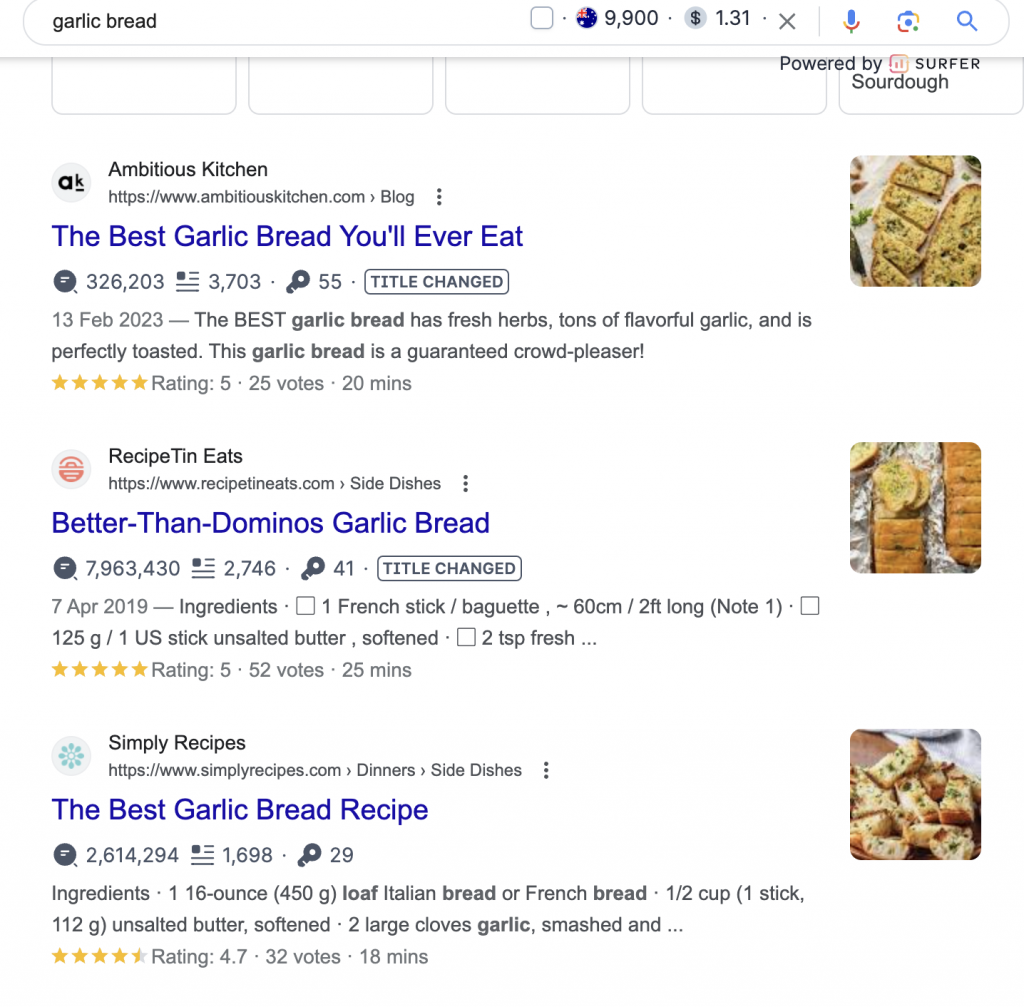
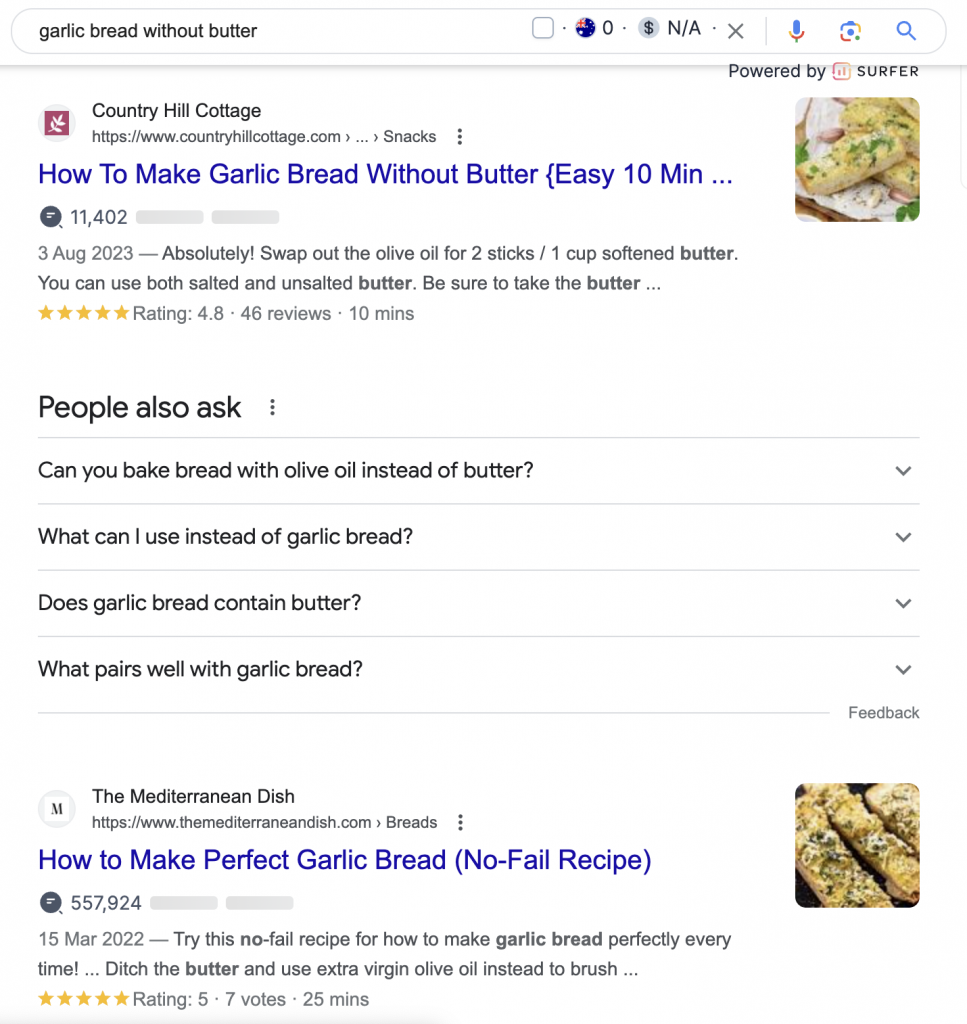
Here, the search results are entirely different.
This indicates that “garlic bread without butter” is not part of the broader “garlic bread” topic, as far as Google is concerned.
Therefore, you’d need two separate pages to target these keywords.
Comparing search results for related keywords helps determine how closely they’re linked and whether one or multiple pages should target them. But this can be overwhelming with many keywords.
Understand the SERP intent and Search intent for SEO
Suppose you’re working with these keywords related to “cold-pressed juice”:
Now, your task is to determine which keywords are best suited for informative blog articles and which are for product or category pages.
For specific keywords, it’s straightforward. For instance, you wouldn’t make a product page for “how to make cold-pressed juice,” as people are likely seeking a guide.
But consider a keyword like “organic cold pressed juice.”
Are users looking for information or to purchase?
This is what we call analyzing search intent in SEO.
Google has ways to determine what users want from a search query. The pages that best meet this intent often rank highest. To understand the intent behind a keyword, observe the top-ranking pages.
Looking at the SERP for “organic cold pressed juice,” we find informational sites and online stores. This mixed search intent suggests you rank with either type of page.
Understanding search intent is more than choosing the right type of page. You should also consider:
- Type – Like a blog post, product page, category page, etc.
- Format – A guide, list, news article, review, etc.
- Angle – Your unique take on the topic.
For example, in search results for “how to make a cold-pressed juice,” one page might focus on making it with specific fruits, another on making it without a juicer.
But what about an article titled “How to Make Cold Pressed Juice Like a Pro Chef”?
This unique angle might attract more clicks than a generic guide.
The key is not just to mimic the search intent exactly. If you have a solid but different perspective on a keyword’s intent and none of the top pages match this, try it out. Even if your page differs from the existing ones, Google might still show it to searchers. If they like it, your page could earn a spot on the SERP.
It’s not just about matching the intent but also about adding your unique angle and approach. This helps in creating content that not only ranks well but also stands out to your audience.
How to prioritize keywords
When you have a list of keywords, it’s important to figure out which ones are worth focusing on first. Each business is different, so there’s no one-size-fits-all answer, but here are some points to consider:
- Traffic Potential
- Ask: How much organic traffic could this keyword bring to my website?
- Consider: The overall search traffic that top-ranking pages for this keyword receive.
- Keyword Difficulty
- Ask: How hard will it be to rank higher than my competitors for this keyword?
- Consider The strength of the current top-ranking pages, including their domain authority and backlink profiles.
- Clicks & Search Volume
- Ask: Are a lot of people searching for this keyword?
- Consider: Not just the number of searches (search volume) but also how likely people are to click on search results (click-through rate).
- Search Intent
- Ask: What are people looking for when they use this keyword?
- Consider: Whether they’re looking to buy something, find information, or locate a website (transactional, informational, navigational).
- User search Journey
- Ask: At what stage in the buying or research process would someone search for this keyword?
- Consider: Whether the keyword is used by people at the awareness, consideration, or decision stage of their journey.
- Keyword Related Topics
- Ask: What other related terms or phrases could be associated with this keyword?
- Consider: Grouping similar keywords together to create more comprehensive and relevant content.
Choosing the right keywords to focus on means looking at how much traffic they could bring, how tough the competition is, what kind of content you need to create, and how valuable these keywords are to your business. It’s about finding the best match for your specific situation.
What’s the best bang-for-buck keywords?
Your approach might vary, but keep things straightforward:
- For Quick Traffic: Target high-volume, low-difficulty keywords.
- For Conversions: Focus on keywords with strong business value.
Getting deeper into the buyer’s journey to pick keywords
Here’s an overview of how to effectively engage visitors at each stage and how it applies to the keywords your choose:
| Stage | Objective | Keywords | Content Delivery |
|---|---|---|---|
| Top of the Funnel (TOFU) | Capture the attention of visitors who have a general idea and are seeking more information. | Choose broad appeal keywords that relate to general issues your product can solve, like “how to end lawn problems” for lawn care products. | Utilize a mix of formats like blogs, videos, podcasts, webinars, and infographics to cater to different preferences. |
| Middle of the Funnel (MOFU) | Address the specific needs of visitors who are considering various solutions to their problems. | Use keywords that connect the solutions proposed in TOFU to more specific queries, like “beneficial lawn care techniques” or “effective tax software.” | Offer detailed content like case studies, eBooks, white papers, and interactive webinars to provide in-depth information and comparisons. |
| Bottom of the Funnel (BOFU) | Convert interested visitors into customers by increasing their confidence in your product. | Use longer, more specific keywords that prompt action, such as “buy organic lawn fertilizer” or “order tax software online.” | Provide free trials, detailed infographics, tutorials, and invitations to newsletters or demos to encourage final purchasing decisions. |
You can create a seamless journey for your organic visitors, turning them from curious browsers into informed, confident customers.
Entity vs Keywords
Entities have become the primary focus behind a Google search, replacing keywords with entity based search.
So, why this change? Let’s break it down.
Keywords, while useful, can be tricky. Imagine searching for “guitar.” What exactly are you looking for? Acoustic guitars, electric ones, or maybe guitar lessons?
This ambiguity can be a headache, leading to search results that don’t really match what you had in mind. Frustrating, right?
Also, keywords are language-specific. When words have different meanings in different languages, it’s tough for search engines to figure out what you’re really after. It’s like trying to understand a joke in another language—something often gets lost in translation!
Remember the early days of Google?
A webpage could rank for just one keyword.
The shift from keywords to entities in Google searches is happening because keywords alone can be ambiguous, language-dependent, and tricky to connect contextually.
This move aims to make search results more accurate and user-friendly. It’s all about understanding the searcher’s intent better and making the whole search experience smoother and more relevant.
Final Word
Keyword research in SEO is about understanding your audience and their needs and then using that understanding to create content they’re actively searching for. This helps you stand out in the vast online world and reach the people looking specifically for what you offer.
Think of it this way: you’re not just collecting a bunch of popular words. You’re trying to understand the stories behind each keyword. What are people trying to find when they use these words? Your goal is to figure out what your potential visitors want and need then provide it to them.


